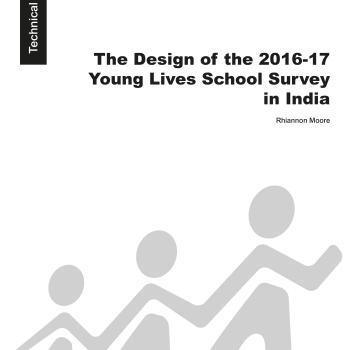Publication Information

Following the Young Lives primary school survey in India (conducted in 2010-11), Young Lives is conducting a survey on secondary school effectiveness in 2016-17. This study will examine school effectiveness through multiple outcome measures: Class 9 students’ performance in Maths, Functional English, and Transferable Skills. Student performance in Maths and Functional English is being assessed using repeated measures, through the administration of linked cognitive tests at the beginning and the end of Class 9 (Wave 1 and Wave 2 of data collection respectively). This will allow students’ progress over the course of one year of secondary schooling to be considered in relation to student, class, teacher and school factors.
The primary school survey in India focused upon Young Lives ‘Younger Cohort’ children (born in 2001-2), tracking them to their schools and classrooms to understand more about their educational experiences and achievement. The secondary school survey, which will take place in 2016-17, and which is the focus on this design note, is structured to collect data from children in the same school grade as many of the ‘Younger Cohort’ (age 15) within a sample of schools in the Young Lives sites in Andhra Pradesh (henceforth AP) and Telangana. This design will generate rich evidence about school and classroom effectiveness and the drivers of learning within schools which the Young Lives cohort of children could access. It focuses on Class 9, the penultimate year of secondary education before children complete secondary school and take the Board Exam at the end of Class 10.
Priority areas for secondary education policy and practice in India have been identified in consultation with key stakeholders at national and state level, including MHRD, Andhra Pradesh and Telangana Ministries of Education, World Bank, DFID-India, Azim Premji and Pratham. These have guided the development of the main research questions for the survey:
How does student learning differ between different types of school? How does teacher motivation, attitude and practice impact on student learning? How does school size and number of teachers (subject-wise) impact on school efficiency and student learning? How do learning and progress differ between students with different media of instruction? What models of school leadership and governance are in place to hold teachers and schools accountable, and how do these relate to differences in school effectiveness? What are some of the factors (in-school and outside school) to which differences in students’ functional English skills can be attributed?

Following the Young Lives primary school survey in India (conducted in 2010-11), Young Lives is conducting a survey on secondary school effectiveness in 2016-17. This study will examine school effectiveness through multiple outcome measures: Class 9 students’ performance in Maths, Functional English, and Transferable Skills. Student performance in Maths and Functional English is being assessed using repeated measures, through the administration of linked cognitive tests at the beginning and the end of Class 9 (Wave 1 and Wave 2 of data collection respectively). This will allow students’ progress over the course of one year of secondary schooling to be considered in relation to student, class, teacher and school factors.
The primary school survey in India focused upon Young Lives ‘Younger Cohort’ children (born in 2001-2), tracking them to their schools and classrooms to understand more about their educational experiences and achievement. The secondary school survey, which will take place in 2016-17, and which is the focus on this design note, is structured to collect data from children in the same school grade as many of the ‘Younger Cohort’ (age 15) within a sample of schools in the Young Lives sites in Andhra Pradesh (henceforth AP) and Telangana. This design will generate rich evidence about school and classroom effectiveness and the drivers of learning within schools which the Young Lives cohort of children could access. It focuses on Class 9, the penultimate year of secondary education before children complete secondary school and take the Board Exam at the end of Class 10.
Priority areas for secondary education policy and practice in India have been identified in consultation with key stakeholders at national and state level, including MHRD, Andhra Pradesh and Telangana Ministries of Education, World Bank, DFID-India, Azim Premji and Pratham. These have guided the development of the main research questions for the survey:
How does student learning differ between different types of school? How does teacher motivation, attitude and practice impact on student learning? How does school size and number of teachers (subject-wise) impact on school efficiency and student learning? How do learning and progress differ between students with different media of instruction? What models of school leadership and governance are in place to hold teachers and schools accountable, and how do these relate to differences in school effectiveness? What are some of the factors (in-school and outside school) to which differences in students’ functional English skills can be attributed?

